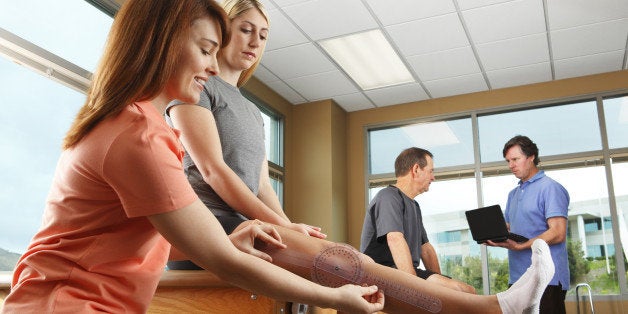
Whether it's an ankle sprain, an aching back, surgery or a broken bone, chances are if you're physically active, you've also been sidelined by an injury.
While both injury and the recovery process can be painful physically and emotionally, the good news is in many cases you'll be able to return to the routine you so dearly love. In a recent study published in the American Journal of Sports Medicine, researchers found that the majority of college athletes who suffer an anterior cruciate ligament (ACL) injury return to play. But as anyone who has recovered from an ACL tear or other physical activity-related injury can attest, that doesn't mean it's easy. Here are a few tips to make it as seamless a process as possible.
Get the (objective) facts.
After you feel a twinge in your knee during your intramural basketball game, your first instinct is probably to do a quick internet search for your symptoms and jump to the worst possible conclusion. But every body -- and therefore every injury -- is unique, and you should run those symptoms by a doctor, not a search engine. "I encourage individuals to gather facts about their injury from medical professionals," says Jennifer E. Carter, Ph.D., director of sports psychology at the Ohio State University Sports Medicine Center. Immediately after the injury, ask questions like, "What's the prognosis? What's the typical course of recovery? What physical activities can I still do?" she says.
If the injury requires a rehabilitation program, that too should be objective, says Pat Davidson, Ph.D., a former exercise science professor and current director of training methodology at Peak Performance in New York City. Ideally, a physical therapist will put you through a "whole-body objective measurement system," he says, for a more global perspective on your pain. He analogizes treating the site of the pain without understanding the rest of the body to making the bed:
If you're putting on your bottom sheet, and the fourth corner doesn't make it, would you say the problem is the fourth corner? Well, not necessarily. One of the other corners probably has too much fabric tucked in, and as a good detective, I would find out which corner is the site of the problem, normalize the problem, and the fourth corner [now] goes on perfectly. Many of us examining our own pain, we're blaming the "fourth corner".
Find a network of care providers.
You'll get the best care, says Davidson, with a team. If you're hoping to get back to working out with a trainer, ideally that trainer will be in close communication with your physical therapist. "That way, the physical therapist can give advice to the trainer and the trainer can give feedback to the physical therapist," he says. If you don't typically exercise with a trainer, a physical therapist may be able to recommend someone trusted to help see you through reentry.
Stop if pain gets worse.
Even with a trainer by your side -- but especially without one -- you're going to have to pay a little extra attention to yourself as you get back into your routine. Take things slowly at first, "making sure that you're not blindly doing movements without focusing on control," says Davidson. And "if you do a movement and the pain ... gets worse, discontinue what you're doing," he says.
Of course, for many athletes, that's easier said than done. "Due to the pressures of sport, some athletes may feel pushed to return before they're ready," says Carter. Check in with yourself and be honest about your pain: Are you minimizing it just because you're tired of sitting on the sideline? "There is no perfect sign that individuals are ready to return, but hopefully they can gradually build back into the physical activity they love," she says.
Find alternatives.
Especially if you're aiming for a specific fitness goal -- running a marathon, setting a new bench press one-rep max -- it can be particularly frustrating to time off from exercise and watch the progress you had made melt away. But depending on what you're trying to maintain, there may be alternative ways to work out that don't affect your injury. Most people, says Davidson, are worried about losing cardiovascular fitness when injured, "because of the health ramifications associated with it," but a number of low-impact forms of cardio, like swimming, cycling or even the elliptical might not cause pain like running, walking or your weekly soccer matches do. Ask your doctor and your physical therapist what activities might still be appropriate. If all else fails, in some cases, says Davidson, even breathing exercises might help.
Learn to love rest.
When's the last time you really took a break? "Overtraining is rampant," says Carter, and even the most dedicated athletes need to build rest and recovery into their training plans. "As athletes cope with the loss of injury, I might ... reframe the injury as an opportunity to rest and recharge and to build mental skills," she says. An injury might feel like forced rest but is still time for the body -- and the mind -- to grow, she says. "Athletes can use the time off ... to practice skills of relaxation, imagery, goal-setting, helpful self-talk, focus and team building."
Acknowledge your emotions.
In a handful of athletes, the emotional turmoil of being sidelined by an injury may be even worse than the physical pain. "Athletes typically feel shock, denial, fear, anger, sadness and/or isolation," says Carter. "Some athletes feel such a sense of loss that it's like they're grieving. About 20 to 30 percent of athletes sustaining severe injuries develop symptoms of clinical depression. Individuals vulnerable to eating disorders might develop destructive food habits after an injury," she says. Tell your doctor if you're feeling particularly down about an injury, as he or she may be able to recommend some mental techniques to help or refer you to someone who can.
Focus on form first.
There are a few "prerequisites" you need before diving back into your fitness routine, says Davidson. He suggests focusing on muscular endurance first, the ability of your muscles, essentially, to not wimp out on you at lower weight and intensity, as well as your ability to simply do the movements properly with good form. "You have to make sure that you have motor control and then [muscular] endurance," he says. "Then you're pretty safe to get back to doing things you normally do."
Set small goals.
Even those of us who feel the most eager to get back into the swing of things might be simultaneously nervous to do so."It's common to fear re-injury," says Carter, "and to experience a dip in confidence upon return."
She suggests focusing on the fact that injuries are sometimes unavoidable in physical activity, but that it's unlikely something will happen again right away. In the meantime, take things slowly, setting small, attainable goals so you can still feel like you're accomplishing something without getting too intense right out of the gate. "Focus on yourself and avoid comparisons to others," she says. Those same mental skills you practiced while you were resting can come in handy, she says, "perhaps deep breaths to stay loose, pre-performance routines, self-talk like 'Be aggressive' or 'Loose and easy' and connecting with teammates."
